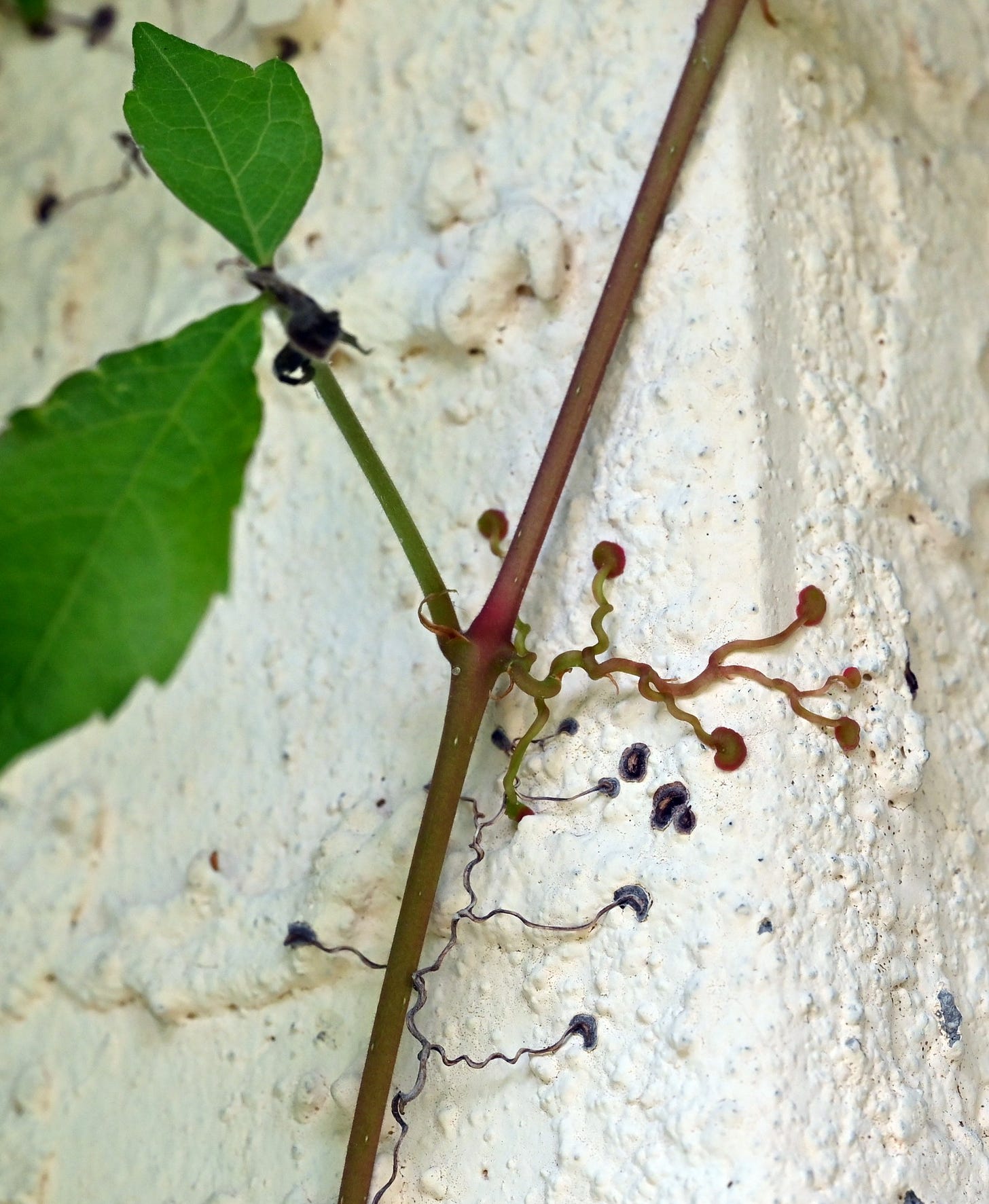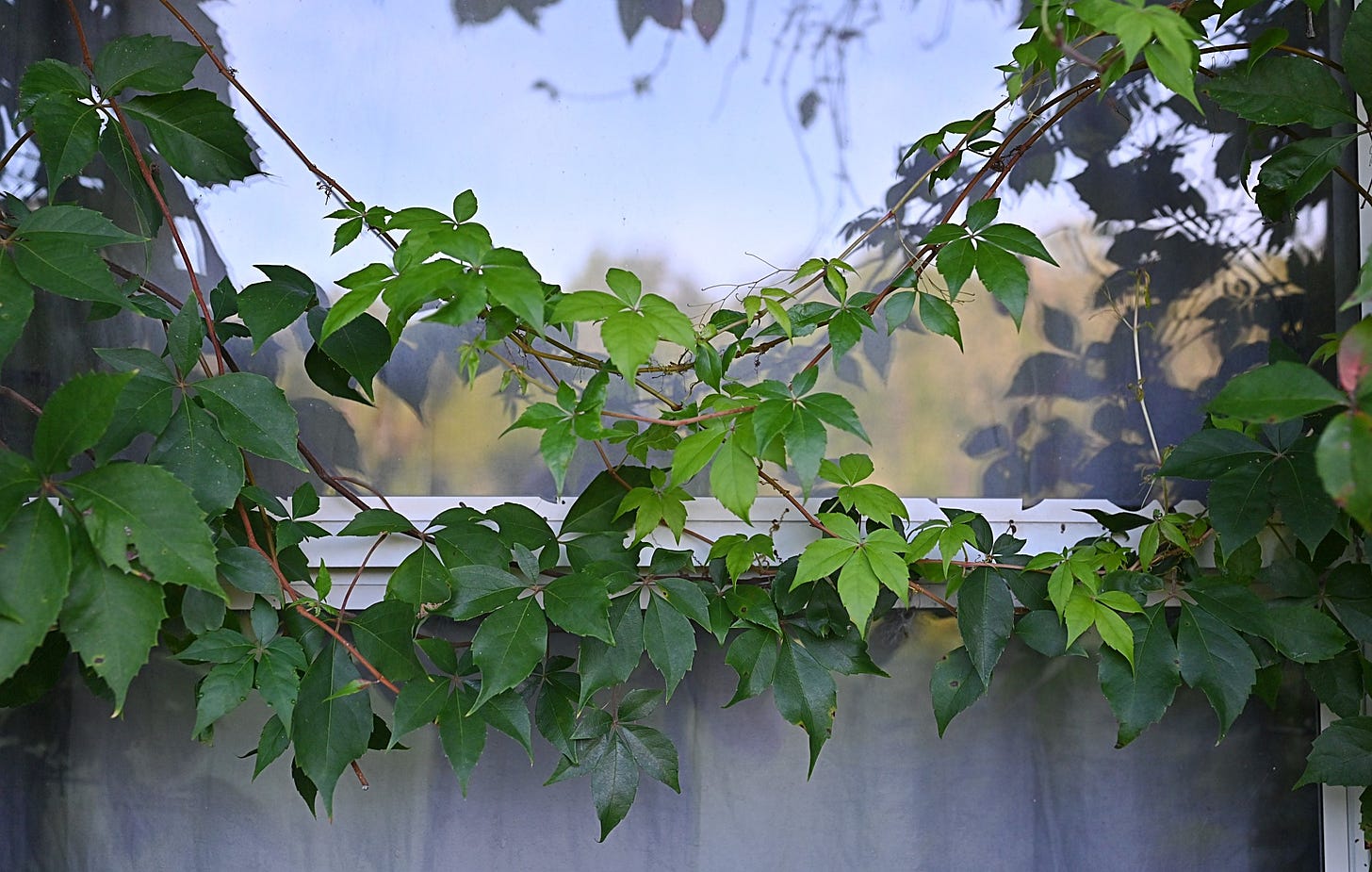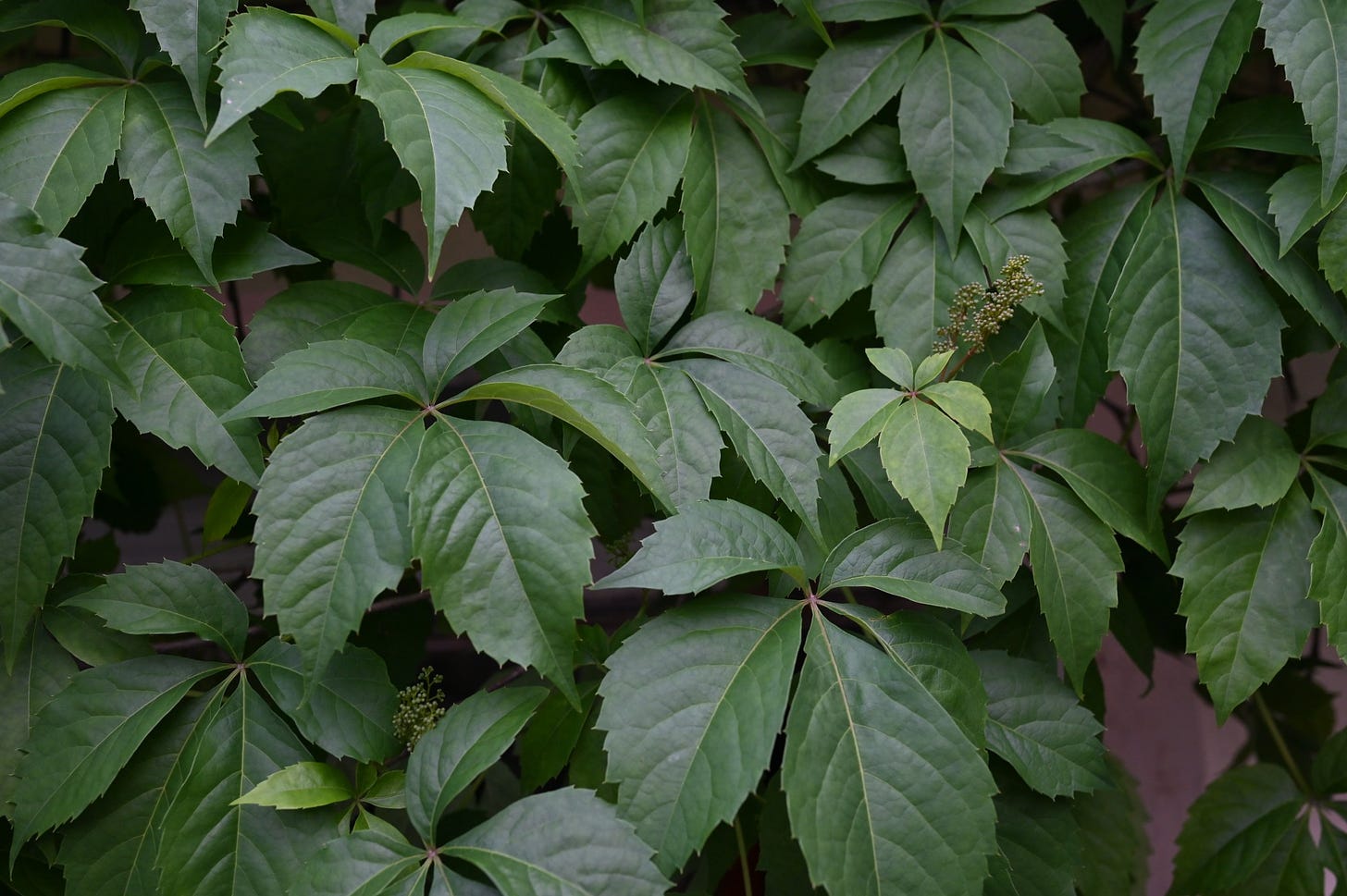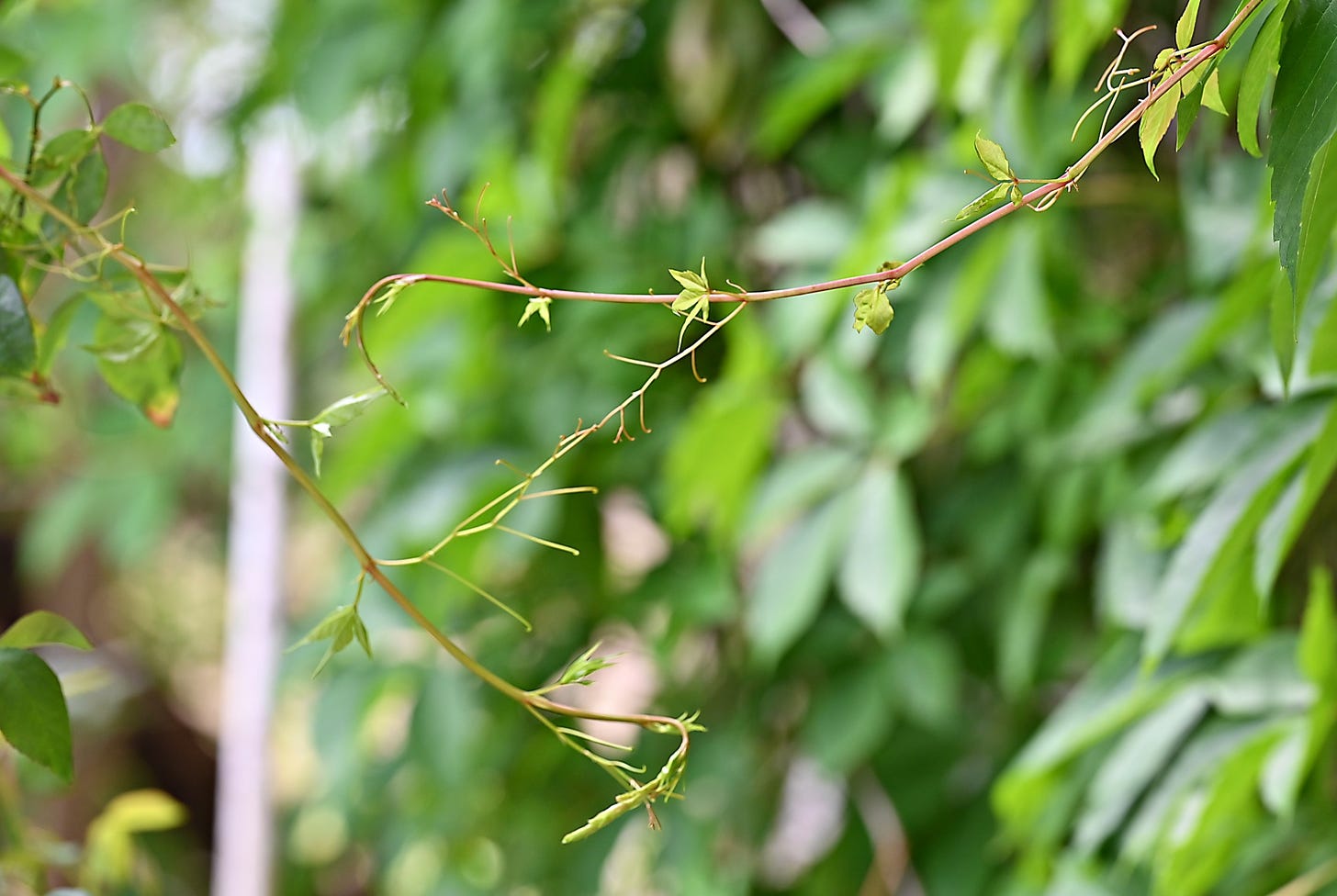Plants clearly have the ability to store and recall biological information.” Daniel Chamovitz, What A Plant Knows
Observations of wild grape vines and hints of self awareness.
After a few years of observing the growth of wild grape vines around the eves of my house, I noticed a curious thing. They know things or at least give the appearance of being aware of their surroundings as they steadily march around my house.
My first observation of this is how the vines interpret and overcome obstacles in their path. The outer walls are stucco so the vine has no issues grappling a hold on the rough texture. The method is to send out tendrils that attach tiny anchor points. It’s truly an anchor and the vine will be securely connected to the wall. Even the hurricane winds here in Florida do not dislodge them. But when the vine reaches the windows the process changes.
 Vines with anchors on a stucco wall.
Vines with anchors on a stucco wall.The vine avoids the glass placing the anchors on the metal frame. It not only has little interest in the glass but more importantly, it never makes the attempt. How does it know that? A built-in genetic database of textures? Where is the sensory input? We are led to believe that plants are not supposed to be self-aware. However, the latest research by botanists has shown how plants have many different sensory functions. Using these senses plants can detect being touched, react to sound, heat, cold and detect water sources in the ground. For example, when a plant is placed on its side the shuts will always grow up and the roots will grow down. Plants have that sort of awareness when changes occur in their environment and their place in it.
 Vines working the window frame but not the glass. Tendrils are then sent out to connect to each avoiding the glass and filling the space above it.
Vines working the window frame but not the glass. Tendrils are then sent out to connect to each avoiding the glass and filling the space above it.The Grape Vines
Wild grape vines are abundant here in Florida. I never saw as many as a child growing up here, as now. They can be the killers of otherwise healthy trees by covering them with their own leaves robbing a tree of the sunlight it needs. A tree seems to have no defense from this onslaught and in time it dies. The vine survives and moves on sending its tendrils elsewhere. They can be as insidious as the more famous green invader, kudzu.
And yes, the wild grape vines produce grapes—about the size of pepper corns or BBs and are inedible.
While most plants are static vines are ever on the move sending their tendrils out as scouts hunting new space. It’s in their DNA programming to be on the hunt. As can been seen the image
What Do Plants Really Know?
The book by Daniel Chamovitz, Pd.D., What A Plant Knows, is an account of plants and their amazing abilities. The book documents the latest research into what a plant sees, hears, feels, remembers, while interacting with its environment. The author makes it clear that what a plant may know is not as deep as human perception of seeing or hearing (or animals for that matter). It doesn’t emote or feel pain. And yet, plants do have remarkable abilities for survival and adapting to their place in the world.
Remarkably, plants do have a memory of sorts as Chamovitz describes it. He refers to psychologist Endel Tulving defined three types of human memory: procedural, semantic and episodic, with procedural being the lowest of the three and procedural memory which is the only one that would relate to plants. It’s the memory of how to do things.
The author goes on to state that scientists have found that plants have glutamate receptors such as we have in our brains for neural communication. Amazing since plants do not have neurons. In plants, glutamate receptors are used for cell to cell communication. Signals can be transmitted or received. So it’s a primitive form of a cognitive ability, but it doesn’t have to be sophisticated. A plant or tree only needs to be able to function as intended, survive and fulfill its purpose. Even still, it can be surprising to learn what their abilities are and how their autonomous systems operate.
So one can assume that at some point the grape vine on my home learned that glass was too slick to attach to. Over time it must have built a database of texture surface types besides learning edge detection and became aware it was coming to a structure that would have a non-slick surface. It has been known for years that plants have a sense of touch (when they are touching, or being touched). Scientist Janet Braam at Rice University made a lot of progress in understanding a plant’s touch processes. She named it the DCH gene. Applying pressure on a leaf creates numerous effects which a plant recognizes aided by the glutamate receptors mentioned above.
They Can Find Each Other
The photo above is an example of how vines reach out and find each other. The tendril to the right is attached to a large batch of vines on the house. The tendril to the left is from another group of vines on the outside of the house. It may have been happenstance that they found a connection. The idea that one vine knew there was a fellow vine and reached out through open space is a bit far-fetched although I don’t doubt it with the amazing abilities plants already possess. Nevertheless, it could very well be an autonomous function with a random hit.
Being an observer of patterns, the vine’s normal template is to find the wall of the house, lay their anchor points and begin the assent. It is interesting how it finds the wall in the first place. But generally it sends runners in all directions. How does it know directions? Just like the plant they put on its side and the shuts still went up and the roots still went down.
In Closing
Although plants and in this case vines, are largely autonomous life, they do give off a hint that there is more going on than meets us at first glance. Their abilities to cope with change with heat, drought, cold, etc., are remarkable. The DNA has some capacity for memory as I have seen in my observations. It knows, somewhere deep down in its genes, to avoid the textures which it can’t bond with and move on to ones it can
Nature is designed and gives us a hint of who the Designer is.
Sources
What A Plant Knows by Daniel Chamovitz, Pd.D.
The Secret Live of Plants by Peter Tomkins and Christopher Bird
All images © 2023 by George W Bailey


